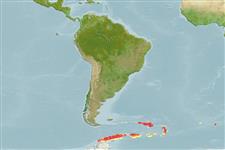分类 / Names
俗名 | 同种异名 | Catalog of Fishes(属, 种) | ITIS | CoL | WoRMS | Cloffa
Environment: milieu / climate zone / 深度上下限 / distribution range
生态学
海洋 居于水底的; 深度上下限 5 - 770 m. 極; 53°S - 65°S, 67°W - 4°E
Southern Ocean: in the vicinity of Bouvet Island, Scotia Sea, and northern part of the Antarctic Peninsula.
南極海: 在鄰近南極半島的布威島, Scotia 海洋與北部。
Length at first maturity / 大小 / 重量 / 年龄
成熟度: Lm 44.9 range ? - ? cm
Max length : 72.0 cm TL 雄鱼/尚未辨别雌雄; (Ref. 4883); common length : 50.0 cm TL 雄鱼/尚未辨别雌雄; (Ref. 2805); 最大体重: 3.7 kg (Ref. 4883)
Adults feed mostly on fish and krill. Synchronous spawner (Ref. 50743). Larvae have a long pelagic phase (Ref. 71843). Utilized as a food fish (Ref. 4931).
大部份捕食鱼与磷虾。 同步的产卵鱼.(参考文献 50743) 作为食用鱼.(参考文献 4931)
Life cycle and mating behavior
成熟度 | 繁殖 | 产卵场 | 卵 | 孕卵数 | 仔鱼
There is only one generation of oocytes in the ovaries indicative of determinate fecundity (Ref. 50743). Mature females may spawn for the first time from around 6-8 years of age (Ref. 71843).南極海: 在鄰近南極半島的布威島, Scotia 海洋與北部。
Hureau, J.-C., 1985. Channichthyidae. p. 261-277. In W. Fischer and J.C. Hureau (eds.) FAO species identification sheets for fishery purposes. Southern Ocean (Fishing areas 48, 58 and 88). Rome. Vol. 2. (Ref. 2805)
世界自然保护联盟红皮书 (Ref. 130435: Version 2025-1)
人类利用
渔业: 低经济
工具
特别资料
下载 XML
网络资源
Estimates based on models
Preferred temperature (参考文献
123201): -1.3 - 1.6, mean 0 °C (based on 42 cells).
Phylogenetic diversity index (参考文献
82804): PD
50 = 1.0000 [Uniqueness, from 0.5 = low to 2.0 = high].
Bayesian length-weight: a=0.00093 (0.00079 - 0.00110), b=3.48 (3.43 - 3.53), in cm total length, based on LWR estimates for this species (Ref.
93245).
营养阶层 (参考文献
69278): 3.4 ±0.2 se; based on diet studies.
回复力 (参考文献
120179): 中等的, 族群倍增时间最少 1.4 - 4.4年 (K=0.17-0.24; Fec = 7,358).
Fishing Vulnerability (Ref.
59153): Moderate to high vulnerability (54 of 100).
🛈
Climate Vulnerability (Ref.
125649): High to very high vulnerability (75 of 100).
🛈
Nutrients (Ref.
124155): Calcium = 24.2 [13.5, 53.3] mg/100g; Iron = 0.45 [0.19, 0.91] mg/100g; Protein = 17.3 [15.2, 19.4] %; Omega3 = 0.23 [0.12, 0.43] g/100g; Selenium = 23.3 [9.2, 53.9] μg/100g; VitaminA = 10.8 [2.2, 52.1] μg/100g; Zinc = 0.364 [0.235, 0.556] mg/100g (wet weight); based on
nutrient studies.
